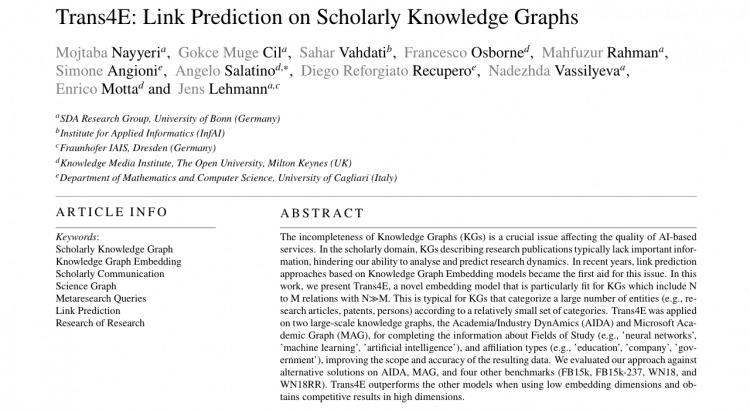“Trans4E: Link Prediction on Scholarly Knowledge Graphs” is a journal paper submitted to the Special Issue on “Knowledge Graph Representation & Reasoning” at the Neurocomputing Journal
Mojtaba Nayyeria, Gokce Muge Cila, Sahar Vahdatib, Francesco Osborned, Mahfuzur Rahmana,Simone Angionie, Angelo Salatinod, Diego Reforgiato Recuperoe, Nadezhda Vassilyevaa, Enrico Mottad and Jens Lehmanna,c
aSDA Research Group, University of Bonn (Germany)
bInstitute for Applied Informatics (InfAI)
cFraunhofer IAIS, Dresden (Germany)
dKnowledge Media Institute, The Open University, Milton Keynes (UK)
eDepartment of Mathematics and Computer Science, University of Cagliari (Italy)
Abstract
The incompleteness of Knowledge Graphs (KGs) is a crucial issue affecting the quality of AI-based services. In the scholarly domain, KGs describing research publications typically lack important information, hindering our ability to analyse and predict research dynamics. In recent years, link prediction approaches based on Knowledge Graph Embedding models became the first aid for this issue. In this work, we present Trans4E, a novel embedding model that is particularly fit for KGs which include N to M relations with N≫M. This is typical for KGs that categorize a large number of entities (e.g., research articles, patents, persons) according to a relatively small set of categories. Trans4E was applied on two large-scale knowledge graphs, the Academia/Industry DynAmics (AIDA) and Microsoft Academic Graph (MAG), for completing the information about Fields of Study (e.g., ‘neural networks’, ‘machine learning’, ‘artificial intelligence’), and affiliation types (e.g., ‘education’, ‘company’, ‘government’), improving the scope and accuracy of the resulting data. We evaluated our approach against alternative solutions on AIDA, MAG, and four other benchmarks (FB15k, FB15k-237, WN18, and WN18RR). Trans4E outperforms the other models when using low embedding dimensions and obtains competitive results in high dimensions.
Download
Download paper from our institutional repository: http://oro.open.ac.uk/77317/
Download paper from DOI (Elsevier): https://doi.org/10.1016/j.neucom.2021.02.100
Download paper from arXiv: https://arxiv.org/abs/2107.03297



